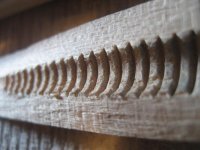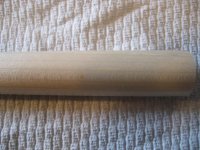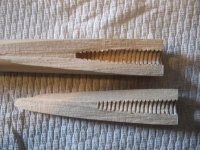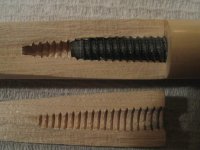This is the second time this has happened. I have my own opinions on what the issue is, just wanted to see if some others have the same. I tried to unclude some of the pics of the grain as well.
You are using an out of date browser. It may not display this or other websites correctly.
You should upgrade or use an alternative browser.
You should upgrade or use an alternative browser.
Failure, Again
- Thread starter fatsix
- Start date
What are you doing when this happens?
<~~~need more info.........
<~~~need more info.........
Phenolic collars help.
this one pictured lasted one break. The shaft that this one replaced did the same after 10 or so games, Except that it was a low right english shot. Never seen this before. Seems that it cant take even the slightest flex.
I could of coarse be wrong but it certainly looks as though the hole is not drilled large enough for the pin. Whom ever used it also may have a follow through like Mike Seagle (spelling) and put a sharp bend in the shaft in this area where the shaft cannot flex.
Dick
I could of coarse be wrong but it certainly looks as though the hole is not drilled large enough for the pin. Whom ever used it also may have a follow through like Mike Seagle (spelling) and put a sharp bend in the shaft in this area where the shaft cannot flex.
Dick
She's only 5'4 120lbs. and there is no powerbreak. Its very odd. I watched it like it was in slow motion. As soon as she hit the CB the shaft deflected and broke. It might be an issue only limited to me. But the old tip was cut off and superglue was smoothed around it to match the size of the ferule. Which leads me to beleive that inferior shaft wood is being used. It looks like there are 6 growth rings and the threads are all chunked out which leaves me to beleive that the wood is not dense enough to machine. It split like a dried out 2x4 from home depot is the best way i can describe it.
I have 3 other cues with no collars on them, and they do not explode when you hit the cueball. Does anyone elses threads look like that inside?
The threads look bad. The hole has a taper , I think he didn't bore deep enough.
Too much pressure at the the end of that thread b/c it looks undersized to me.
Take a pic with the cue's joint screw under that and we can tell better.
She's only 5'4 120lbs. and there is no powerbreak. Its very odd. I watched it like it was in slow motion. As soon as she hit the CB the shaft deflected and broke. It might be an issue only limited to me. But the old tip was cut off and superglue was smoothed around it to match the size of the ferule. Which leads me to beleive that inferior shaft wood is being used. It looks like there are 6 growth rings and the threads are all chunked out which leaves me to beleive that the wood is not dense enough to machine. It split like a dried out 2x4 from home depot is the best way i can describe it.
I have no understanding what this would have to do with the joint splitting.
Could very well be inferior wood if it has happened before and the wood has came from the same batch. Seeing that the wood has fractured opposite the grain pattern leads me to believe it may be something else.
There is definitely something not right if heavy side pressure is not included in the equation.
Who made the pin?
Last edited:
I would have to put a phenolic joint ring on there. This should help. One other thing is this happened when you were breaking, ussually means that you are pulling up on the back end of the cue also during your follow through. Try to keep your cue level as possible.
The shaft did get replaced last time for free, but i had to pay shipping. So when i send it back again. I will be paying for shipping on this one cue for the third time. If it keeps up like this,shafts being replaced monthly, i would have paid enough in shipping to cover the cost of the cue. The reusing of the no name brand tip and then try to cover up the difference in dia with superglue ticks me off. I'd be more understanding if they explained that they couldnt reuse the tip and i had to pay for a new one. So the whole experience leaves a bad taste in my mouth with the lack of quality and confidence of this being fixed properly.
6 grain lines on a finished shaft, would mean that there were at least 8 grain lines to the INCH (when it was still at the 1 in. size). That is plenty strong enough to withstand any normal amount of abuse. There is no doubt that even an 1/8" wide collar on this shaft, would have strengthened it hugely. HOWEVER.... In 25 years of making & repairing cues I have NEVER seen a hole drilled & taped with that severe of a taper at the end of the threads. From the looks of the threads , I would say that the pilot hole , drilled before threading, was too small. It appears that the screw FORMED the threads, instead of the tap CUTTING the threads. I also believe that with this threading system only a small amount of side pressure would result in shaft failure. I can only guess that the cuemaker is VERY new to this & should never use this hole size OR tap...JER
P.S. Because the hole was improperly formed, the WAX added additional side pressure, that contributed to the failure.
P.S. Because the hole was improperly formed, the WAX added additional side pressure, that contributed to the failure.
Last edited:
The hole isn't tapered. The break is angled and the screw seems to fit fine. The screw threads aren't compressing the lands of the hole threads.
At some point in the life of the shaft, enough lateral pressure was applied to the shaft while a screw, a drill, or a tap was inside the hole, to cause the split. Breaking the balls didn't do this. No collar is a big gamble as you have found out.
At some point in the life of the shaft, enough lateral pressure was applied to the shaft while a screw, a drill, or a tap was inside the hole, to cause the split. Breaking the balls didn't do this. No collar is a big gamble as you have found out.
If the joint pin or shaft threads are not straight when you tighten up the shaft it will put a side load on the shaft threads as the joint faces tighten up and the joint pin flexes to compansates for the missalighnment.
I am thinking that the wood is stressed when being threaded. Then when you break or play hard, not much extra is required to put it to break. A collar reinforces the OD of the shaft and can reduce the chance of breaking. All that being said, I have seen many shafts that do not have collars and are not broken.
I think that if a larger hole was used and the hole taped or threaded deeper,would reduce this stress.
In normal play, it shold have been strong enough.
I have also seen people when they break push down on the cue after the cue has hit the cue ball and put alot of pressure bending the joint pins and then complaining that the cue was not built strong enough. The reality is, that technique can be the cause of failure rather than workmanship.I knpw of a guy that breaks most 2 piece cues in existance when he breaks, because puts so much pressure on the cue the bending either breaks or bends the joint pins. So he carries his own 1 piece breakcue with a hard tip just for the purpose.
Neil
I think that if a larger hole was used and the hole taped or threaded deeper,would reduce this stress.
In normal play, it shold have been strong enough.
I have also seen people when they break push down on the cue after the cue has hit the cue ball and put alot of pressure bending the joint pins and then complaining that the cue was not built strong enough. The reality is, that technique can be the cause of failure rather than workmanship.I knpw of a guy that breaks most 2 piece cues in existance when he breaks, because puts so much pressure on the cue the bending either breaks or bends the joint pins. So he carries his own 1 piece breakcue with a hard tip just for the purpose.
Neil
Pictures generally will only tell part of the story. Based on what I'm seeing in the pictures everything looks to be "ok" (i'll use this term loosely). All I can say is for that shaft to break the way it did there had be some forces applied to it somewhere, somehow. Whether it was in the construction end or the users end it is hard to point the finger when neither of these have been seen. We are only looking at the result of.
If your wanting to keep the shaft a collar-less sneaky style look ask your guy to inset a collar on the face of the shaft. That way it'll only be seen when it's broke down, something around .250 deep, .100 thick will give some added strength......or try a phenolic insert.
If your wanting to keep the shaft a collar-less sneaky style look ask your guy to inset a collar on the face of the shaft. That way it'll only be seen when it's broke down, something around .250 deep, .100 thick will give some added strength......or try a phenolic insert.








